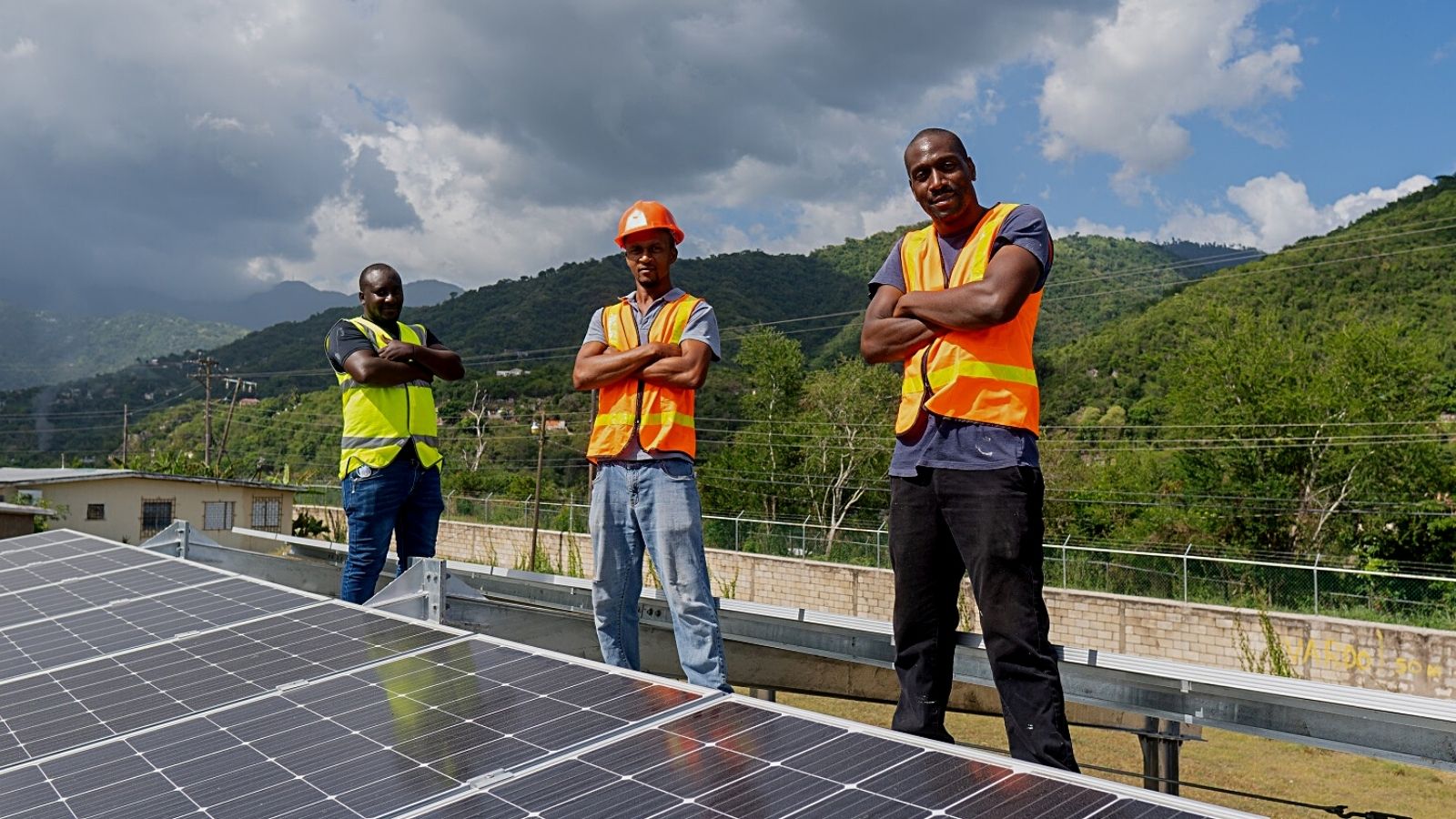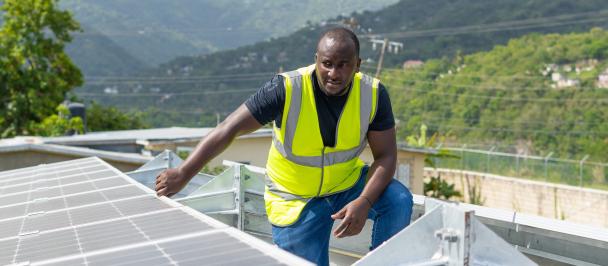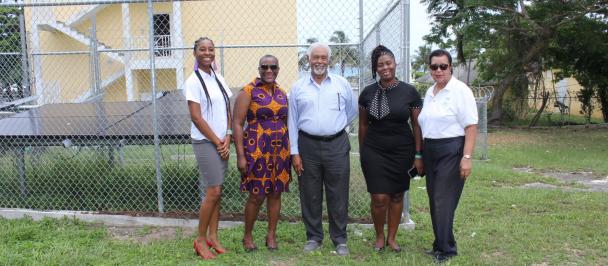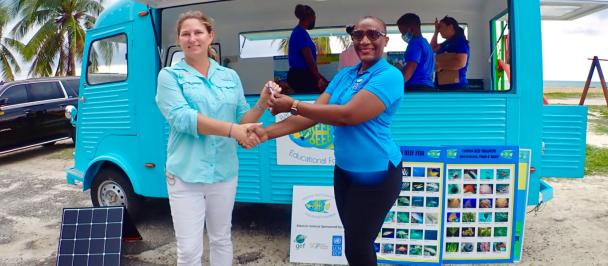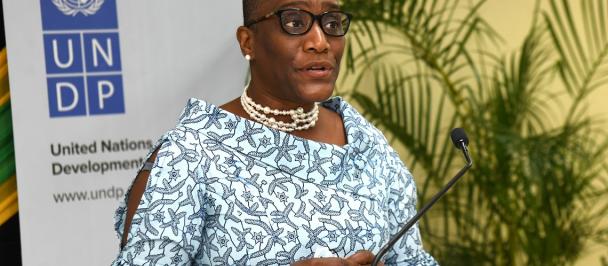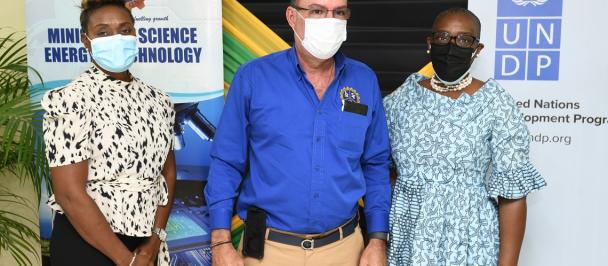Damion Lawrence (centre) Maintenance Supervisor for National Chest Hospital and Sir John Golding Rehabilitation Centre, and team, poses with the solar installation at the rehab centre.
Click for Full Photo Story with tons of High-resolution photos and video features
Trading fossil fuels for sun rays and incandescent lighting for LEDs, has been illuminating clean and green options for powering Jamaica's public hospitals at reduced cost and carbon footprint.
There is a calculated bonus: Savings generated from these renewable and energy efficient solutions can be re-routed from recurrent expenditure into improving the lives and human development prospects of the Jamaican people.
This sums up the core mission of the Deployment of Renewable Energy and Improvement of Energy Efficiency in the Public-Sector project funded by the Global Environment Facility (GEF) with a $1.25 Million USD grant: Run select hospitals on a clean energy mix in order to release public funds for critical development projects. Document. Adapt. Repeat what works.
6 out of Jamaica's 24 hospitals targeted
Implemented 2016 to 2021 by UNDP Multi Country Office in Jamaica in partnership with the Ministry of Health and Wellness and the Ministry of Science, Energy and Technology, the project retrofitted six of Jamaica's 24 public hospitals with LED bulbs and installed grid-tied solar photovoltaic systems at three of the six. Staff was also trained to operate and maintain the systems to secure sustainability of the investment.
Maintenance supervisors like Carlton Grant of May Pen Hospital based in a large town in south central Jamaica have a close-up of the impact: “It’s a very, very good initiative. We have saved a lot on our electricity and as you know a hospital is where you use high voltage. At this time our bills should be cutting by more than half. This is very good not just for the hospital but for the Ministry of Health and Jamaica as a whole. It's a very good cost saving.”
Projected Savings
Energy consumption at the six participating hospitals was running 4.8 million kilowatt hours every year before the retrofits, Expert analysis conducted by former UNDP project manager Tenny Daley indicates the solar and LED investment is on track to save $348,944 USD per annum at all six hospitals.
At the three hospitals selected for both LED and solar retrofits, average annual savings is expected to be one third of their current spend. Multiyear savings for all six hospitals is projected at $3.5 million USD.
The interventions are expected to reduce the public health sector energy consumption bill by 22% annually, according to the Minister of Science, Energy and Technology Hon. Daryl Vaz. Twenty two percent is a welcome milestone for the Government of Jamaica which has set a benchmark of 15% reduction in overall public sector energy consumption by improving energy efficiency and deploying Renewable Energy.
Over five-years (2013 to 2018) government entities had already generated US$2.2 million in savings, cut its fossil fuel consumption by 3500 barrels, and reduced its carbon footprint 5800 tons in fulfilment of this policy position, states 2019 news reports attributed to former Science and Technology Minister Fayval Williams; by 2020, a nine-year assessment reported 3.2 Million USD in savings.
Green energy initiatives are rigorously pursued due to the potential impact on the public purse. Government was billed USD $171 million in 2012, with the health sector accounting for 6% of the total bill. Fossil fuels make up one third of Jamaica’s import bill – a whopping 15% of GDP – which impacts the ability of the government to invest in key social sectors such as education, health, and social safety nets.
With 2500 to 3000 hours of bright sunshine annually, Jamaica’s options for exploiting this sustainable energy source are immeasurable, and the GEF-funded project is making it possible to generate 'sun powered' savings for sustainable development.
“This is a very significant project to the health sector. Energy consumption is a critical part of our operations,” states Leslie James, the Ministry of Health and Wellness’ senior director for project management and health facilities. “To a large extent this is a very impactful project, and we hope to be able to expand to other facilities to see a change in our energy consumption in health facilities,” he says.
Maintenance has been taken care of for the next three years, working in tandem with technical staff, James points out. He says “the capacity building training is helping to create a culture change so that people are more aware of energy consumption and measures to reduce consumption.” To this end, monitoring has been digitized, enabling hospital operations and maintenance teams to remotely monitor solar energy generation via secure login on smart devices. The hospitals are now observing daily and monthly kilowatt of energy generation on demand.
Jacqueline Ellis, Chief Executive Officer of two of the participating hospitals – National Chest Hospital and Sir John Golding Rehab Centre – says the expected reduction in electricity bills is welcome as this is a major cost driver for the health sector. “The fact that we are working with a tight budget - savings in that area will definitely help us as an organization”, she states.
“When we were using the incandescent and the fluorescent bulbs our light bill was very high,” recalls Milton Grant from May Pen Hospital. “Since we put in the LED and our solar panels, we have long lasting life span on the tubes which is very good”, he reports.
A six-month trend analysis of the LED bulb retrofit in just three of the participating hospitals in 2020 confirms they had cut energy use an average 17.6%, saving $1.5 million JMD. This resulted in a modest but promising reduction of 30 tons of CO2 and a reduction of 25 barrels of oil over that short period.
The project was ambitious in its intentions to spread similar impacts to the average householder and small business, by seeking to facilitate the birth of an Energy Services Company (ESCO) industry in Jamaica. Tenny Daley calls the ESCO “a unique model to reduce upfront costs of renewable energy and energy efficiency interventions, while managing design and installation from start to finish”. Although the goal was not realised, the project was able to sow seeds that await further work to bear fruit.
The industry now needs standardization so that all the players know the requirements, says Enbar Consulting Principal Consultant David Barrett, an advocate for the ESCO industry. He praised the GEF-funded project for providing tools and training in ESCO measurement and verification and the energy performance contract which standardizes the expectation between the client and the provider.
“If the ESCO market takes off … we will have standardized procedures, ultimately reduce the amount of energy consumed and massively increase levels of renewable clean energy that we utilize”, he says.
For now, plugging into the sun and opting for cooler, efficient lighting solutions is creating a blueprint for energy-productive, cost-efficient operations for local hospitals. Experts and advocates look to teams from six local hospitals for a harvest of data to light the way forward.

 Locations
Locations